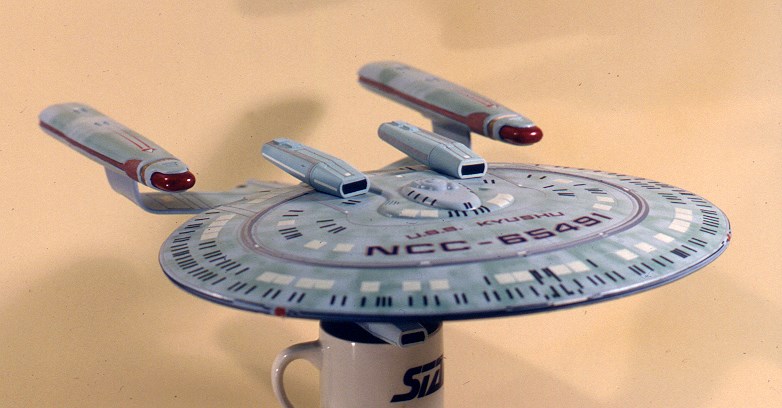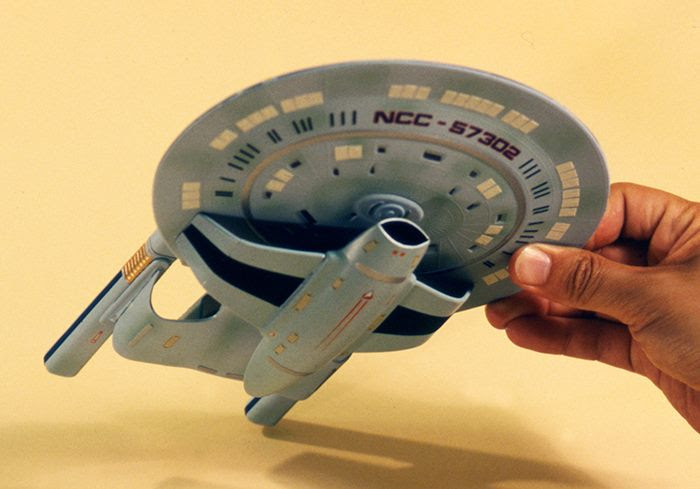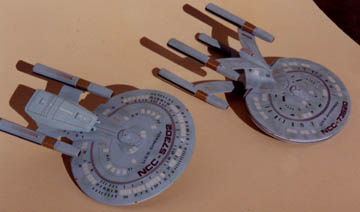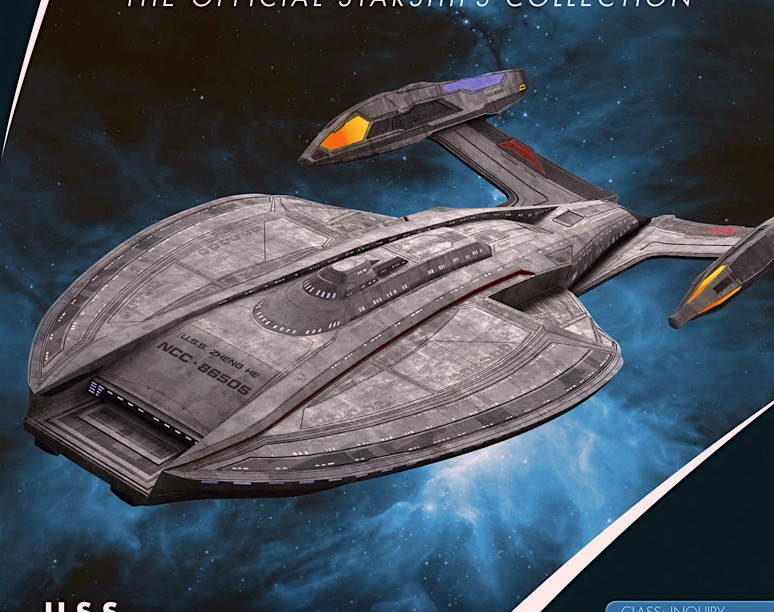11
"I wonder if the Emperor Honorius watching the Visigoths coming over the seventh hill truly realized that the Roman Empire was about to fall."
Prophetic words. Although Wolf 359 did not result in the fall of the Federation, the Federation would never, could never, be the same after that.
How does a society react to something like Wolf 359? Especially a society like United Federation of Planets that has never seen carnage on this scale before? I mean, sure, there were a lot of lives lost in the Klingon Wars, but those were battles that the Federation could fight and hold their own in. Not this time. 39 ships and 11000 lives lost in a matter of minutes. Wiped away by the Borg with a single ship in moments. Honestly, I think about 9/11 or Pearl Harbor and the responses to those events. The horrified, dumbfounded shock. Followed by the anger and the fear.
As
@Scionz said above, the altercations with the Cardassians, Tzenkethi and Ferengi of recent history could not possibly adequately prepare the rank-and-file of Starfleet for something of this magnitude.
And Shelby says she'll have the fleet back up in a year. That's a massive reallocation of resources and I doubt that this task force stopped at those 39 ships. We also know that Benjamin Sisko, who would have just lost his wife, will be recruited into this task force and will be part of the team that designs the Defiant class starship. A warship. No science labs. All guns and engines. That definitely represents a shift in priorities from the Federation and Starfleet brass.
I would have loved to seen more of a reaction from the Federation as a whole to these events. We know the people of Earth are aware of some of the things that happened. The mayor of Labarre wanted to hold a parade for Picard.
And Picard himself will never be the same after this. We will see that these events still haunt him 32 years later. The scene with Picard and his brother in the vineyard, with Picard sobbing uncontrollably over what was done to him, should have earned Patrick Stewart an Emmy nomination.
The contrast between Wolf 359 in 2367 and the Battle of Sector 001 in 2373 couldn't be starker. The Federation got chewed up and spit out at Wolf 359. Modernized 23rd and mid-24th century ships fired ineffective weapons, had shields that were basically useless, and were often disabled (as seen in "Emissary") once the Borg tractor beam got hold of them. They also evidently did no damage and brought their families to what was probably the Federation's biggest fleet engagement in the past 70 years. There is no evidence to think that in the Cardassian Border Wars, the Tzenkethi conflict or any other known minor military faces off, the Federation had assembled anything close to the scale of the 40 Federation ships at Wolf 359. Heck the loss of the Enterprise C, a single ship, in 2344 was defining to mid 24th century politics. THe irony is the 40 ships fielded and the 39 ships lost would be dwarfed by the scale of fleets and losses during the Dominion War from 2373-2375, which were ten, sometimes twenty times the size.
The composition of the Wolf 359 fleet is interesting namely the dearth of Ambassadors and the presence of obscure ships of that share Galaxy-class design cues. Clear pictures of these have finally popped up in the last decade, and Eaglemoss saw them all made into collectibles and CG models for the first time.
(eaglemoss above)
Since a big part of Star Trek from a chronological perspective is ships, especially the "hero ships", I like to think that all of these classes represent a late 2340s to mid/late 2350s attempt by Starfleet to engage in risk reduction. I wrote about this before elsewhere (maybe in this thread, I can't recall), but Starfleet landed on the Constitution-class design (and more so: series of associated technologies) that formed the foundation of it from the mid-23rd century until around 2300. It replaced what we know now as the "Battle of the Binary Stars" generation of ships that fought in the Klingon-Federation war of the 2350s. And while the cruiser-type Constitutions were largely out of service by 2300, the Mirandas, which have a big modular hindsection, stuck around until at least 2381 (Lower Decks). The Excelsior "great experiment" in Transwarp may have failed, but as I wrote earlier, probably succeeded in making Warp 9 normal by Starfleet, and thus allowed for the much larger Federation of the 24th century. The many Excelsior variants and technologies played a key role in the 24th century.
The Ambassador class... we never saw many of them. At least one showed up at Wolf 359 and was promptly destroyed. And we never saw any during the Dominion War. It clearly didn;t represent a class successful enough to replace modernized Excelsiors. In fact, scrolling through Memory Alpha for the Excelsior class something jumps out right away - the registry numbers are in blocks! This is really really cool from a relating-it-to-the-real world perspective. These are the blocks:
Block 1: "NCC-2000s" (USS Excelsior, Repulse, Enterprise B). These would probably all be 2390s first-run Excelsiors.
Block 2: "NCC-14000s" (USS Techumseh, USS Berlin, USS Fearless). These would probably be second-run Excelsiors, in the early 2320s.
Block 3: "Around 40000", with a low of the Intrepid (38907) to a high of the Archer (44278). These would probably be third run Excelsiors, around the 2340s/2450s. Most excelsiors we've seen are this block. The USS Lakota (Enterprise-B variant) was NCC-42768.
Block 4: "Late Run Excelsiors", ranging from the Melbourne (62043) to the Atlantis (72007). This puts them in the 2350s and 2360s. In fact the Galaxy class prototype, USS Galaxy, had a registry of 70637, which means the Atlantis entered later.
It's a certainty the Federation kept the basic hull and kept updating the technology so a Block 4 Excelsior was a highly capable mid-century cruiser that wasn't a capital ship program like the Galaxy class, and probably a more work-efficiently design than the Ambassador, which seemingly had no advantages over the Excelsior (by contrast, the Galaxy class's advantages are quite clear). If I haven't made it clear, I think the Ambassador class is pretty much a great lemon by Starfleet. A lot of ambition and good ideas but 20 years too early, not unlike the Zumwalt-class destroyer of the US Navy.
So those Wolf 359 ships..... I've long thought they mostly represent Starfleet taking technologies intended for the Galaxy-class megaproject and breaking them up to prototype and field-test them them at a smaller scale, integrated with some proven technologies, before combining them all together for the first time in the USS Galaxy. That's exactly what modern Naval shipbuilders do. The Galaxy-class shaped saucer for example is a feature that only shows up on the Galaxy class and the Wolf 359 ships, and is a radical departure from the Excelsior, Ambassador and Constitution classes. They featured phaser arrays, a special semi-pearlescent hull plating and narrow windows. It's fair to think Stafleet built scaled-down version of the Galaxy class saucer, and plugged it into a proven secondary hull and nacells, because the test was the saucer. One of these classes has a too-large-for-the-saucer bridge module... so not unrealistic to think it was a test bed for the bridge and computer to manage the ship, again at scale. The Freedom-class's only has a single Galaxy-class nacelle on it, but the nacelle design is so revolutionary and crucial to the class's success that you'd want to test it independently. The Springfield-class USS Chekov is among the most interesting. It has a sensor pod that would be a dead-ringer for a prototype Nebula-class sensor pod (or galaxy-class sensors-in-a-box), and a secondary hull that would be perfect as a testbed for the Galaxy class's revolutionary deflector.
Side note: the Parliament-class and California-class of Lower Decks all show Galaxy-class-derived saucers and are likely 2360s spin-offs of these "Battle of Wolf 359" designs into "behind the lines" ships (like the Cerritos). But they have no features of what would come in the wake of Wolf 359, with the Saber, Akira, Sovereign, Steamrunner, Norway and now (also from Lower Decks) Luna class.
The thought of these Wolf 359 ships as an evolutionary step between Ambassadors / Block 3 Excelsiors and the Galaxy class is compelling because the only ones we ever saw were at Wolf 359. And that kind of makes sense. Admiral Hansen through together that fleet with whatever Starfleet had in range. It's probably these test-bed ships, of which there may be only a couple or a few examples of, were kept close to home. Some, we could figure, were even doing developmental work on the next class of starship, before being called into service, where they were destroyed.
And yet, for getting wiped out in 2367, but by 2373, the revisions to the fleet that came in the wake of Wolf 359 (and given clear urgency by the impending Dominion War that would come within months), had clearly worked. Federation ships took big hits and kept on fighting by the Battle of Sector 001. Their shields did not collapse. They did extensive damage to the Borg cube before the Enterprise-E showed up. And it did take insider-knowledge from Captain Picard, but they had the firepower to destroy a Borg Cube without adaptation by it. And while losses were again, high, it wasn't close to total.
Wedged between this, of course, is the first contact with the Dominion in 2370. The producers of DS9 purposely made Captain Keogh a Picard-analogue, and the USS Odyssey an Enterprise-D stand in. The point was to send the message that our TNG heroes would have faired no better versus the Jem'Hadar. The Galaxy class fought them like they fought every encounter in the 2360s: standing still and relying on superior firepower and its shields. Except it didn't work at all. The polaron beams ignored the shields and the lack of maneuverability made it prone to multi-vector and ultimately a suicide ram attack. Federation shields really didn't get any better until the 2372. Galaxy-class ships ultimately did do well in the Dominion War, but they kept moving and had their flanks covered by smaller, agile ships. In fact, "small and agile" came to define the Federation after Wolf 359. Even their biggest post-Wolf 359 ship, the Sovereign class, was highly agile and streamlines. And lest we forget: this streamlining is not some obscure "action movie" invasion into Star Trek as a result of First Contact. If we go back to "Peak Performance" in Season 2, the war game (staged in response to the Borg threat via dialogue), Picard's first command was to present a minimal aspect ratio to the Hathaway - basically turning the ship at an angle relative to the Hathaway to make the ship as small a target as possible.
In 2021, "the Best of Both Worlds" is a 31 year old episode, but I think its presence in Star Trek is not just an inflection point for the franchise (and its fictional universe / continuity), but also a waypoint in how science fiction sees space itself. TOS, like most space-science fiction in the 1950s and 1960s focused on the unknown mystery of the cosmos. It's a mindset shifted towards mystery and a lack of understanding. Even as late as 1984, with the Voyage Home, Star Trek emphasised this point. V'Ger and the Whale Probe were not out to destroy. They were only destructive because of a misunderstanding.
But in the mid 1980s, perhaps as a result of the upheavals of the 1970s, end of Apollo, and later Challenger, the optimism of space started to drain away and we started to get more and more "Space Horror". That is, the unknown mysteries of the cosmos are dangerous and can, and probably want to kill you. Aliens, Predator, the Thing all are elements of that shift.
The Borg were Star Trek's first expression of it, and the Dominion is its second. The Federation, as we observed in this thread, is very capable of dealing with species, even intractable foes, who operate in much the same way they do - a government, diplomats, trade, territory, interests. When they look at the Klingons or the Romulans they see variations on themselves or what they could be. The Romulans were Vulcan offshoots. The Klingons were not unlike what the Andorians could have become, and even to a degree, what the Terran Empire in the Mirror Universe did become. So how does that approach deal with the Borg, which is (at the time) leaderless, faceless and not interested in the things the Federation is? How does that approach deal with the Dominion, which wants the submission of all potential rivals as a way to assuage the Founder's millenia-old paranoia about solids, and do so with an endless army of disposable troops? It doesn't.
"Q Who" was the Federation truly being perfectly introduced to a galaxy outside of its little bubble it barely understood (and arrogantly thought it did understand). The Best of Both Worlds was that reality intruding into the Federation's little paradise. And it wouldn't even be the worst.
Relating this to the real world again, back in 2014 when Russia invaded Ukraine and annexed Crimea, President Obama decried Russia's "19th Century Foreign Policy that has no place in the 21st century". But we've seen in the years since, by Russia, by China, by the US and others, that in fact the foreign policy mode of operation of the post-Cold War era, starting in 1992, that for 20 years was taken for granted and delusionally seen as self perpetuating and the new normal, was in fact, the aberration. That 19th century foreign policy he decried was not just of the 19th century, but of all but 20 years of the 20th century, and the 18th, and the 17th, and the 16th. Obama - very much not alone in this by the way - saw changing borders and using military power to advance a national agenda as an aberration and didn't have the tools in place to address it. The US did not move our navy and air force into position to force Russia's compliance with the global order. Maybe it would have done that 40 years ago, but not in 2014. The modern system is not equipped to process such disruption.
In evaluating how the Federation would have reacted to Wolf 359, I think that, not Pearl Harbor, is an proper analogue. Imperial Japan was understandable at some level. The US and Imperial Japan had been contesting influence in the Western Pacific for 20 years before the attack. The US wouldn't have done its version of a Pearl Harbor, but the aims were logical from the Japanese perspective, because fundamentally both Japan and the US wanted similar things: political, economic and military influence / dominance of part of the Pacific. But as we've seen since 2014, as the US has ratched up sanctions and penalties, Russia just does not care and has tightened its grip on Crimea. It's been extraordinarily difficult for an entire generation of US diplomats who thought in terms of "win-wins" and making everyone "productive stakeholders" to figure out how to respond to an adversary who just doesn't want and operate in the same manner. In fact, there are some big names in foreign policy who STILL will not let go of the way things were for 20 years, particularly since the same thing is happening now with China.
Relating that to the Federation, I think we'd have to see significant consequences. There would have be massive institutional change (like happened in the US after 9/11, and now).. It would likely end the political prospects of the sitting Federation President. Starfleet Command, which badly misjudged - I'd even say failed - to anticipate security needs as the Federation spread further into the galaxy, would have to be cleaned up. That may even explain the ascension of more militant Admirals in subsequent years, like Pressman, Leyton, Nechayev, Dougherty and Ross. They may have been the minority in the "exploration" era, but quickly came to drive Starfleet priorities, with a tilt towards security, starting around 2369. 18 months would be sufficient for there to have been house cleaning at Starfleet. Unambiguously, I think it's clear that it meant the end to the ill-conceived "families on ships" policy. The next large explorer - the Sovereign class - did not have families and was extremely heavily armed. The smaller post-2370 ships did not have accommodations for them. Picard's point of view about that policy ultimately ended up being the correct one. Writing this, I'm just thinking how when Julian Bashir first saw the Defiant sickbay, he said it was "laughable". I think that just underscores how, well, spoiled, Federation officers were in the 2360s (something Scotty pointed out in Relics when he saw his room). The sickbay the Defiant class was clearly not enough to perform a surgery like a full spinal column replacement that the Galaxy-class could handle, but as we later saw, clearly sufficient for the types of combat injuries the crew of a warship would likely encounter. Again, there is a 2360s perspective thing going on that clashes against the realities that the world they were walking into was changing.
The irony is, Wolf 359 was probably as small price to pay. If Q never accelerated the Federation's encounter with the Borg, the Federation would have been assimilated. If the Borg were never encountered at all, but the wormhole still opened, there is little doubt the Dominion would have rolled over a Federation which didn't have years of Borg-related defense work that could be repurposed to that conflict (like the Defiant and it's cousins). 11,000 dead in 2367 would be dwarfed by the engagements in which 70,000 Starfleet and 80,000 Klingons would die by 2375. But that's the price of survival in an ever more dangerous galaxy.
We've only seen one certifiably post-Dominion War class ship: the Inquiry class of 2399. I'm gonna say - I'm not that big a fan of the design. Made by John Eaves, I think we're seeing what happens when one of the main ship designers of the late TNG era isn't challenged by producers to revise the design to conform to certain "in universe rules" that enhanced the designs of other ships, like the Sovereign-class and NX-01. It's not the worst, but is very "first draft" to me. But even still, we see the post-Wolf 359 lessons carried forward: sleakness, a low profile with a lot of emphasis on a defensive design, fewer windows, sharper edges, an "unibody design", a more armored hull and a strange deflector. It seems, at least that in-universe the lessons delivered during Wolf 359, carried forward into the Dominion War, would be with Starfleet for the next 30 years.












